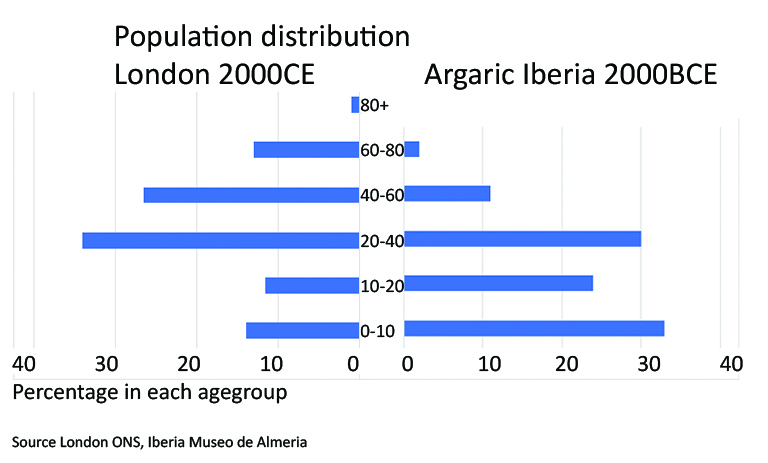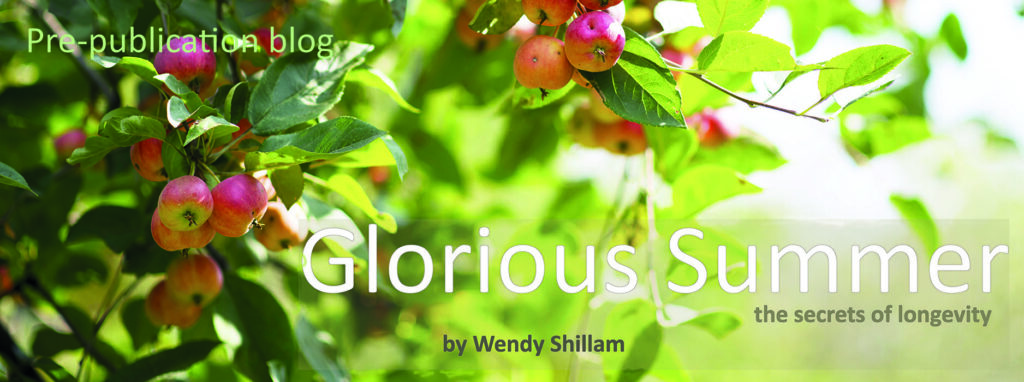There is increasing evidence that from about 10,000BCE, after people settled and started tending crops and domesticating animals, that diet improved, health improved and longevity started to rise. Despite the fact that nothing was written down, there were no birth certificates and memory can play tricks on us even today, we can learn a lot about longevity from archaeology. By inspecting bones from Bronze Age burial sites all around the Mediterranean from ancient Egypt to Iberia, we can discover a lot about how long early civilised people might have lived and died[i].
I discovered the Argaric civilisation by chance, because these people lived in the same village that I do in south eastern Spain. Even though four millennia separate me from their habitation of Mojácar, I feel an affinity for these people, who like me lived in a small village on a hillside, overlooking the meandering Rio Aguas. This river is bone dry in summer, but after winter rains, it swells, bursting its banks and streams fertile mud across the dead flat fields that flank it. The river flows on, into the Mediterranean half a kilometre away, where it deposits the last of its muddy load, producing a cloud of debris that attracts feeding fish in multitudes. The village I live in today owes its existence to medieval Moorish invaders, but underneath the blocky whitewashed houses we live in, there is evidence of much a earlier community. Even though I have lived here on and off for over forty years, I didn’t know anything about the Bronze Age settlers until I happened to have a little time to kill one day in Almeria’s new archaeological museum.
For over thirty years, and unbeknown to me and my neighbours, archaeologists have been working to unravel the story of this very early civilisation. I suspect they kept it pretty quiet because some of the tombs are richly adorned. In one a solid silver diadem has been found, and is now proudly displayed in the museum.
You can find remnants of early Bronze Age settlements all around the Mediterranean, that indicate a marked change in lifestyle from the stone-age hunter-gatherers whom they supplanted. The Iberian Argaric peoples, who settled my village, built granaries, grew crops, tended cattle and traded in the abundant precious metals that stud the violently folded volcanic rocks of the Sierra Cabrera that rise up behind the coastal strip.
Archaeologists have to work with what they find, using broken pots, the indent of foundations or the content of mizzen heaps, to piece together the life of people long dead. One of the most fertile lines of enquiry is to examine bones from burial sites. These days radio carbon dating not only gives us very clear evidence of the year in which people died, isotopes within the bones can tell us what people ate, especially if, as exist here, remnants of the bones of animals they might have eaten, or vestiges of seeds and pips from cereals and fruit are also available to test. Forensic archaeologists can tell us the age of the bodies, and how healthy each person might have been. They can even speculate about their medical history, injuries and if they suffered from malnutrition or diseases during their lives.
What is particularly interesting is that the pathologists had been able to tell us about the longevity of the Argaric population. While there were definitely fewer old people in the Bronze Age, by comparison to today, some people still lived to ripe old ages. In this one tiny area, a snapshot of the entire population and their entire history, they have found bones of people who died in their late seventies and eighties. If you look at the comparison below between London in the 2nd millennium CE and estimates that the Museum of Almeria have done for an Argaric village in the 2nd millennium BCE the differences are instructive.

By looking at the graph you can see that about the same proportion of the population were between 20 and 40. London has 34% of its population, while the Argaric people had about 30%.
In those days, child mortality would have killed off many young people before they had ever reached their first birthday. Before they reached their twenties, starvation, infections, diseases, fighting and accidental injuries would have killed off many more. There is evidence that this was a violent society. The museum estimated that in order to support an adult working population not dissimilar in percentage terms to London today, that 55% of the population at any one time would have been under twenty. Many of those children would not have survived into adulthood. That reduced the number of old people, but the dramatic death rate would have been amongst children. Hundreds of children’s graves have been found.
These days we have more older people, not particularly because the survivors are living longer, it is simply that fewer of them are dying in childhood, before their time. Old age is not new, but perhaps our attitude to it is.
It is sobering to discover that some Bronze Age peoples might actually have been healthier than we are. One grave that was excavated in Cuevas de Almanzora, just down the coast from my village, revealed the body of a man, aged between 55 and 65. With him were buried the symbols of his status, including food, a bronze knife, a dagger and a solid gold bangle as thick as my thumb. Despite his age, his body revealed no signs of injury or arthritis. He had few rotten teeth consistent with having eaten a healthy diet all his life. He’d never experienced the toxicity of modern pollution, or the excess fats and sugars of a processed diet. He’d never become a couch potato, having doubtless been required to walk or ride donkeys everywhere. His diet, low in animal fats, but high in lean proteins, fruits and vegetables, supplemented with fresh milk, cheese and wholegrain bread would make a modern nutritionist proud. In many ways he was eating the archetypal Mediterranean diet that we consider so healthful today.
But it was only the upper classes who benefitted in Bronze Age Iberia. Less fortunate members of society suffered from the toxicity and danger of mining copper infused with arsenic. The graves of young male serfs reveal injuries consistent with bloody battles. This civilisation discovered how to forge bronze swords and knives because they needed them; life was brutal. It is thought that agrarian ‘serfs’ who tended the unprotected but fertile valley farmland and lived-in hovels among their crops, were treated little better than slaves. The overseers and village leaders, lived in protected villages on the hillside. They grew rich by trading copper, silver and gold and exploiting those who worked for them. The poor died, the wealthy survived.
In many parts of the developed world life expectancy has shrunk in recent years, due perhaps to our poor diet and exercise regimens as much as the pressures of modern life. Almost two thirds of UK adults are overweight. The Centre for Disease Control and Prevention (CDC) estimate that 71% of the US population are overweight and about 40% of them obese. In the UK many children enter primary school overweight and leave six years later obese. Our education system is not teaching them to eat well, or encouraging them to exercise. Diabetes type 2, the form of diabetes that used to be uniquely found in older people, has been recently diagnosed in children. Some toddlers suffer terrible traumas having their milk teeth extracted because of childhood tooth decay, due to excess consumption of sugar. How can we be damaging children so much that their health is dangerously compromised even before they reach school age?
Sadly, the iniquity we find in Bronze Age cemetries still exists today. Where you live, your level of education, your income, ethnicity and line of work will all influence your chances of a healthy long life. In the UK you will live longer if you live in the south east, if you are white, wealthy and well educated. You are less likely to suffer from limiting long term conditions, your diet is likely to be healthier, you won’t drink or smoke so much. Your job and your housing are less likely to expose you to injury, overcrowding, dampness, poor ventilation, toxins and pollution. If you earn above the average, you are more likely to live in a neighbourhood blessed with public parks, community facilities and support. There will be more libraries and cultural centres, more art galleries, tennis courts, swimming pools and concert halls. You will be more likely to be able to occupy your mind with stimulating activities that stave off dementia and stimulating exercise in a safe environment. You will feel safe walking or jogging. And if you do become ill, the local health system is less likely to be overwhelmed. You may even have private health insurance that can allow you to jump the queue.
Amongst the Argaric peoples who lived 4,000 years ago, we see civilization helping a healthier population to thrive. We see some people living as long as we can hope to live. But for them, as it still is for us, the chances of longevity is more available to the upper classes. Sadly, our so-called advanced civilization reveals similar social divisions to those of past millennia. In the UK in 2020 social, geographical and economic factors all influenced the risk of serious illness or death from COVID-19, yet the one most mentioned was age. Age did have an effect, but the effects of deprivation multiplied the risks. Studies found higher levels of disease among ethnic minorities, people suffering from disability, mental issues and dementia.
We might consider ourselves more civilised these days, but the iniquities we find in the modern world would have been recognised just as much by people who lived in my village, all those years ago. In London in the first wave of the virus in 2020 one of the highest death rates from COVID-19 was among bus drivers. Being ‘on the buses’ is a poorly paid, sedentary and stressful job at the best of times; being public facing during 2020, it became lethal.
FOOTNOTE
[1] This blog is about agrarian man, whose diet, society and lifestyle were closer to ours. Peoples started living like this about 10,000 year ago in the fertile crescent of Mesopotamia, India and China, people spread out from there to the fringes of the Mediterranean and elsewhere. There is no evidence of longevity in Palaeolithic, Mesolithic and Neolithic hunter-gatherer societies that went before this, where disease and malnutrition were rife and evidence suggests that living beyond middle age would have been extremely rare. Bad news, I’m afraid, for anyone who thinks that the paleo diet is the way to go. A varied agrarian diet, where protein from animal sources can be augmented by cereals and dairy, produced healthier, more long-lived humans.
This year I shall be maintaining a weekly blog, covering pre-publication excerpts from the book as well as a series of articles about the science and the scientists who have unlocked the secrets of longevity. Please register your interest by clicking on the mailing list below.
A beta reader is a test reader of an unreleased work (similar to beta testing in software), who gives feedback to the author, from the perspective of an average reader. If you’d like to help me get this book as good as it can be, I’d love to hear from you. The chapters will be ready from June onwards. I’m sorry there is no fee for this work, except a free copy of the finished book and an acknowledgement. This is not a commercial exercise. Say Tomato, the publisher of the book and of the website is run as a self-financed social enterprise. I shall be eternally grateful. Any profits from Glorious Summer will be directed into Say Tomato work for women over 40.
Contact me directly wendy@wendyshillam.co.uk if you are interested, giving a brief description of yourself and your reading experience. (It doesn’t matter if you haven’t done any beta reading before – avid readers make the best beta readers.) Thank you.


Wendy Shillam
Trained in environmental and bio-sciences, Wendy Shillam is a registered clinical nutritionist, specialising in longevity. She is the founder of the social enterprise Say Tomato! that was provides free and trusted weight loss advice for women over forty.

Hi Wendy,
Another interesting blog. As a probationary beta reader though, I think it ‘serfs’ rather than ‘surfs’.
Oops! Thanks! Now changed.
W